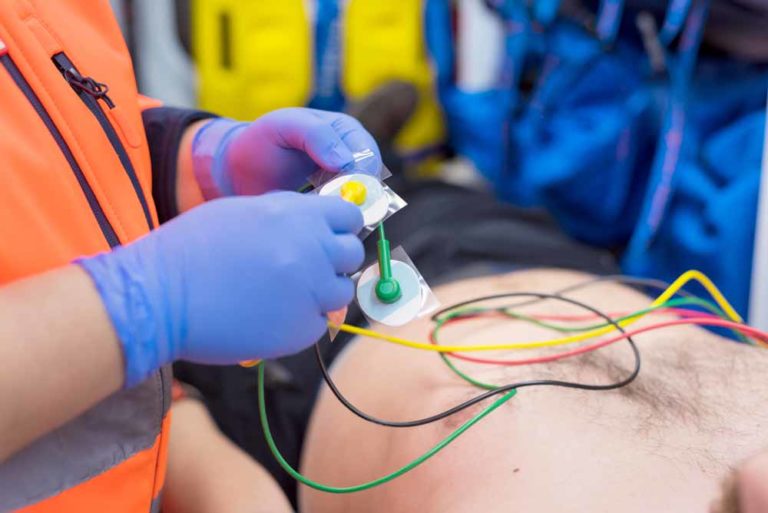Chest Pain History Taking / OSCE guide

Diagnoses and conditions accompanied by chest pain
- Acute coronary syndrome:
- Myocardial infarction
- Unstable angina
- Stable angina
- Pericarditis and myopericarditis
- Myocarditis
- Dissection of the aorta
- Pneumonia
- Pneumothorax
- Pleurisy
- Tension pneumothorax
- Pulmonary embolism
- Ruptured esophagus
- Pancreatitis
- Stomach ulcer
- Reflux echophagitis
- Biliary tract disease
- Esophageal motility disorders
- Musculoskeletal disorders as a cause of chest wall pain (eg, due to trauma, overexertion, or costal chondritis)
- Fibromyalgia
- Tumors of the chest
- Herpes zoster infection
- Idiopathic Pain Syndrome
Chest Pain History Taking
- Opening the consultation
- Wash your hands and don PPE (personal protective equipment) if appropriate
- Introduce yourself to the patient including your name and role
- Confirm the patient’s name and date of birth
- Explain that you’d like to take a history from the patient
- Gain consent to proceed with taking a history
- Presenting complaint
- Use open questioning to explore the patient’s presenting complaint
- History of presenting complaint
- Site: ask where the pain is
- Onset: clarify when the pain first started and if it came on suddenly or gradually
- Character: ask the patient to describe how the pain feels
- Radiation: ask if the pain moves anywhere else
- Associated symptoms: ask if there are any other associated symptoms
- Time course: ask how the pain has changed over time
- Exacerbating or relieving factors: ask if anything makes the pain worse or better
- Severity: ask how severe the pain is on a scale of 0-10
- Explore the patient’s ideas, concerns, and expectations
- Summarise the patient’s presenting complaint
- Systemic enquiry
- Screen for relevant symptoms in other body systems
- Past medical history
- Screen for conditions that may be associated with chest pain
- Ask about other medical diagnoses and previous surgical history
- Ask if the patient has any allergies and if so, clarify what kind of reaction they had to the substance
- Drug history
- Ask if the patient is currently taking any prescribed medications or over-the-counter remedies
- Ask if the patient if they’re experiencing any side effects from their medication
- Family history
- Ask if there is any family history of diseases relevant to chest pain and clarify at what age the disease(s) developed (e.g. cardiovascular disease, thromboembolic disease)
- Social history
- Explore the patient’s general social context (accommodation, who the patient lives with, how the patient manages with activities of daily living, care needs)
- Take a smoking history
- Take an alcohol history
- Ask about recreational drug use
- Ask about problematic gambling
- Ask about diet and exercise
- Ask about the patient’s occupation
- Ask if the patient drives
- Closing the consultation
- Summarise the salient points of the history back to the patient and ask if they feel that you’ve missed anything
- Thank the patient for their time
- Dispose of PPE appropriately and wash your hands
- Key communication skills
- Active listening
- Summarising
- Signposting
Opening the consultation
- Wash your hands and don PPE (personal protective equipment) if appropriate
- Introduce yourself to the patient including your name and role
- Confirm the patient’s name and date of birth
- Explain that you’d like to take a history from the patient
- Gain consent to proceed with taking a history
General communication skills
It is important you do not forget the general communication skills which are relevant to all patient encounters. Demonstrating these skills will ensure your consultation remains patient-centered and not checklist-like (just because you’re running through a checklist in your head doesn’t mean this has to be obvious to the patient).
Some general communication skills which apply to all patient consultations include:
• Demonstrating empathy in response to patient cues: both verbal and non-verbal.
• Active listening: through body language and your verbal responses to what the patient has said.
• An appropriate level of eye contact throughout the consultation.
• Open, relaxed, yet professional body language (e.g. uncrossed legs and arms, leaning slightly forward in the chair).
• Making sure not to interrupt the patient throughout the consultation.
• Establishing rapport (e.g. asking the patient how they are and offering them a seat).
• Signposting: this involves explaining to the patient what you have discussed so far and what you plan to discuss next.
• Summarising at regular intervals.
Confirm the patient’s name and date of birth using the next questions:
| Full | Short |
| “What is your first name?” | “Your first name?” |
| “What is your family name?” “Can you tell me what your family name is?“ | “Your family name?” |
| “Any other names?” | |
| “What`s your date of birth?” | “Your date of birth?“ |
| “When were you admitted?” | “The date you were admitted?” |
| “Can you tell me what your address is?” | |
| “Who is your GP?” |
Presenting complaint
6. Use open questioning to explore the patient’s presenting complaint
- “What’s brought you in to see me today?”
- “What`s brought you along today?“
- “What`s brought you here?“
- “Tell me about the issues you’ve been experiencing.”
- “Can you tell me what seems to be bothering you?”
- “What seems to be the problem?”
- “What can I do for you?“
Provide the patient with enough time to answer and avoid interrupting them.
Facilitate the patient to expand on their presenting complaint if required:
- “Ok, can you tell me more about that?”
- “Can you explain what that pain was like?”
Open vs closed questions –> History taking typically involves a combination of open and closed questions. Open questions are effective at the start of consultations, allowing the patient to tell you what has happened in their own words. Closed questions can allow you to explore the symptoms mentioned by the patient in more detail to gain a better understanding of their presentation. Closed questions can also be used to identify relevant risk factors and narrow the differential diagnosis.
History of presenting complaint
Gather further details about the patient’s chest pain using the SOCRATES acronym.
SOCRATES
The SOCRATES acronym is a useful tool for exploring each of the patient’s presenting symptoms in more detail. It is most commonly used to explore pain, but it can be applied to other symptoms, although some of the elements of SOCRATES may not be relevant to all symptoms.
- Site: ask where the pain is
- Onset: clarify when the pain first started and if it came on suddenly or gradually
- Character: ask the patient to describe how the pain feels
- Radiation: ask if the pain moves anywhere else
- Associated symptoms: ask if there are any other associated symptoms
- Time course: ask how the pain has changed over time
- Exacerbating or relieving factors: ask if anything makes the pain worse or better
- Severity: ask how severe the pain is on a scale of 0-10
| S | Site | Ask about the location of the pain | • “Where is the pain?” • “Can you point to where you experience the pain?” • “Can you show me where it hurts?” • ” What body parts are involved?” • “Which part of your (head) is affected?” • “What is the site of the pain?” |
| O | Onset | Clarify how and when the pain developed | • “Did the pain come on suddenly or gradually?” • “When did the pain first start?” • “When did the symptoms start?” • “Did the pain come on at rest or whilst you were exerting yourself?” • “How long did the pain last for?” • “How and when did it start?” • “When did the pain start, and was it sudden or gradual?” • “What were you doing then?” • “Is there anything special that brings on the pain?” • “When does the pain come on?” • “Do you know what contributory causes are cause the attacks?” • “When the attacks seem to be worse?” |
| C | Character | Ask about the specific characteristics of the pain: | • “How would you describe the pain?” • “Is the pain constant or does it come and go?” • “What is the pain like?” • “Can you describe the pain to me?” • “Is it continuous or does it come and go?” • “What is the character of pain?” • “Is the pain worse now?” • “Is the pain continuous?” |
| R | Radiation | Ask if the pain moves anywhere else | • “Does the pain spread elsewhere?” • “Does the pain go/ radiate/ move anywhere else?” • “Is the pain just in one place or has it moved anywhere else?” • “If the pain is moving to another part of the body, where is this, and is it constant?” • “Is the pain there all the time?” • “In which part of the body has the pain radiated before?” |
| A | Associated symptoms | Ask if there are other symptoms that are associated with the pain | • “Are there any other symptoms that seem associated with the pain?” • “Do you have any other symptoms apart from the pain?” • “Does anything else happen while you have the pain?” • “What other symptoms are present and associated with the pain?” • “Are there any other symptoms?” |
| T | Time course | Clarify how the pain has changed over time | • “How has the pain changed over time?” This question can be useful to determine if the chest pain has become progressively worse over time. An example might be a patient describing chest pain that was initially only present during exertion which is now also present at rest (e.g. unstable angina). • How long have you had this pain? • Does it happen at specific times of the day, or is it constant? • When does the pain occur/start? |
| E | Exacerbating or relieving factors | Ask if anything makes the pain worse or better | • “Does anything make the pain worse?” • “Does anything make the pain better?” • “Does anything change the pain?” |
| S | Severity | Assess the severity of the pain by asking the patient to grade it on a scale of 0-10 | • “On a scale of 0-10, how severe is the pain, if 0 is no pain and 10 is the worst pain you’ve ever experienced?” • How bad is the pain on a scale of 1 to 10? • Can you describe your pain on a scale of 1 to 10? • Is it bad enough to (wake you up)? This allows you to assess the patient’s response to treatments (e.g. pain was initially 8/10 and improved to 3/10 with GTN spray). |
Be polite, use for questions “Can you tell me…?” or “Can you describe…?”
For example:
- “Can you tell me where it hurts?”
- “Can you tell me what your pain is like?”
- “Can you tell me where she works?”
- “Can you tell me what your symptoms are?”
Adjectives for pain
| Aching |
| Scalding/burning |
| Crushing |
| Dull |
| Excruciating |
| Gripping |
| Intense |
| Persistent |
| Piercing/boring |
| Severe |
| Shooting |
| Spasmodic |
| Thunderclap |
| Vague |
Shortness of breath can accompany cardiac pain. For the assessment of shortness of breath ask the patient “Have you had any shortness of breath?“
Typical presentations of chest pain
Acute coronary syndrome:
- Sudden onset central crushing chest pain radiating to the left arm and/or jaw lasting longer than 20 minutes.
- Associated symptoms can include sweating, clamminess, nausea and shortness of breath.
- Symptoms are often worsened by exertion and improved with GTN spray.
Stable angina:
- Sudden onset central chest pain radiating to the left arm and/or jaw lasting fewer than 20 minutes with complete resolution of pain during rest.
- Often triggered by exertion and resolved with GTN spray and/or rest.
- Associated symptoms include shortness of breath.
Pericarditis:
- Gradual onset of central chest pain worsened by lying flat and improved by leaning forwards.
- Associated symptoms can include fever and fatigue.
Thoracic aortic dissection:
- Sudden onset central chest pain radiating through to the back and often described as ‘tearing’ in nature.
- Associated symptoms include pre-syncope and syncope secondary to haemodynamic instability.
Pneumonia:
- Gradual onset of sharp chest pain worsened by deep inspiration (pleuritic in nature).
- Associated symptoms include productive cough, shortness of breath, fever and malaise.
Spontaneous pneumothorax:
- Sudden onset sharp chest pain worsened by deep inspiration.
- Associated with shortness of breath.
Pulmonary embolism:
- Sudden onset chest pain worsened by deep inspiration (pleuritic in nature).
- Associated symptoms include shortness of breath and haemoptysis (rare).
Gastro-oesophageal reflux:
- Gradual onset central chest pain that is typically described as burning in character and worsened by lying flat.
- Associated symptoms can include nausea and vomiting.
Oesophageal spasm:
- Sudden onset central chest pain relieved by GTN spray (hence it is often confused with acute coronary syndrome).
- Associated symptoms can include dysphagia, heartburn and regurgitation.
15. Explore the patient’s ideas, concerns, and expectations
A key component of history taking involves exploring a patient’s ideas, concerns, and expectations (often referred to as ICE) to gain insight into how a patient currently perceives their situation, what they are worried about, and what they expect from the consultation.
The exploration of ideas, concerns, and expectations should be fluid throughout the consultation in response to patient cues. This will help ensure your consultation is more natural, patient-centered, and not overly formulaic.
It can be challenging to use the ICE structure in a way that sounds natural in your consultation.
| Ideas | Explore the patient’s ideas about the current issue | • “What do you think the problem is?” • “What are your thoughts about what is happening?” • “It’s clear that you’ve given this a lot of thought and it would be helpful to hear what you think might be going on.” |
| Concerns | Explore the patient’s current concerns | • “Is there anything, in particular, that’s worrying you?” • “What’s your number one concern regarding this problem at the moment?” • “What’s the worst thing you were thinking it might be?” |
| Expectations | Ask what the patient hopes to gain from the consultation | • “What were you hoping I’d be able to do for you today?” • “What would ideally need to happen for you to feel today’s consultation was a success?” • “What do you think might be the best plan of action?” |
16. Summarise the patient’s presenting complaint
Summarise what the patient has told you about their presenting complaint. This allows you to check your understanding of the patient’s history and provides an opportunity for the patient to correct any inaccurate information.
Once you have summarised, ask the patient if there’s anything else that you’ve overlooked. Continue to periodically summarise as you move through the rest of the history.
Systemic enquiry
17. Screen for relevant symptoms in other body systems
A systemic enquiry involves performing a brief screen for symptoms in other body systems which may or may not be relevant to the primary presenting complaint. A systemic enquiry may also identify symptoms that the patient has forgotten to mention in the presenting complaint.
Deciding on which symptoms to ask about depends on the presenting complaint and your level of experience.
Some examples of symptoms you could screen for in each system include:
| System | Symptoms |
| Systemic | fevers, weight change, fatigue |
| Respiratory | dyspnoea, cough, sputum, wheeze, haemoptysis, pleuritic chest pain |
| Gastrointestinal | dyspepsia, nausea, vomiting, dysphagia, abdominal pain |
| Genitourinary | oliguria, polyuria |
| Neurological | visual changes, motor or sensory disturbances, headache |
| Musculoskeletal | chest wall pain, trauma |
| Dermatological | rashes, ulcers |
Past medical history
- Screen for conditions that may be associated with chest pain
- Ask about other medical diagnoses and previous surgical history
- Ask if the patient has any allergies and if so, clarify what kind of reaction they had to the substance
Cardiovascular risk factors
When taking a cardiovascular history it’s essential that you identify risk factors for cardiovascular disease as you work through the patient’s history (e.g. past medical history, family history, social history).
Important cardiovascular risk factors include:
- Hypertension
- Hyperlipidaemia
- Diabetes
- Family history of cardiac disease
- Smoking
| Ask if the patient has any medical conditions | • “Do you have any medical conditions?” • “Do you have any chronic illnesses?” • “Are you currently seeing a doctor or specialist regularly?” |
| Ask if the patient has previously undergone any surgery (e.g. coronary artery bypass grafts, coronary artery stents, heart valve replacements) | • “Have you ever previously undergone any operations or procedures?” • “When was the operation/procedure and why was it performed?” |
If the patient has a medical condition, you should gather more details to assess how well controlled the disease is and what treatment(s) the patient is receiving. It is also important to ask about any complications associated with the condition including hospital admissions.
Examples of relevant medical conditions
Cardiovascular disease:
- Hypertension
- Hyperlipidaemia
- Angina
- Myocardial infarction
- Obesity
- Chronic kidney disease
- Atrial fibrillation
- Stroke
- Peripheral vascular disease
- Rheumatic fever
Respiratory disease:
- Pneumonia
- Pneumothorax
- Pulmonary embolus
Gastrointestinal disease:
- Gastro-oesophageal reflux
- Oesophageal spasm
| Allergies | Questions |
| Ask if the patient has any allergies and if so, clarify what kind of reaction they had to the substance (e.g. mild rash vs anaphylaxis). | • “Do you know if you are allergic to any drugs?” • “What symptoms do you have after taking it?” |
Drug history
- Ask if the patient is currently taking any prescribed medications or over-the-counter remedies
- Ask if the patient if they’re experiencing any side effects from their medication
| Ask if the patient is currently taking any prescribed medications or over-the-counter remedies | • “Are you currently taking any prescribed medications or over-the-counter treatments?” • “Are you taking any medication at the moment?” • “Do you use any over-the-counter remedies or herbal or homeopathic medicines?” • “How many times a day?” • “Do you always remember to take medicines?“ |
| If the patient is taking prescribed or over-the-counter medications, document the medication name, dose, frequency, form, and route. | |
| Ask the patient if they’re currently experiencing any side effects from their medication | • “Have you noticed any side effects from the medication you currently take?” • “Do you know if you are allergic to any drugs?” • “What symptoms do you have after taking it?” |
Medication examples
Medications commonly prescribed to patients with medical conditions relevant to chest pain:
- Anticoagulants (e.g. pulmonary embolism)
- Antiplatelets (e.g. coronary artery disease)
- Statins (e.g. coronary artery disease)
- Glyceryl trinitrate spray (e.g. angina, oesophageal spasm)
- Calcium channel blockers (e.g. hypertension)
- ACE inhibitors (e.g. hypertension)
- Antibiotics (e.g. pneumonia)
- Colchicine (e.g. pericarditis)
Family history
23. Ask if there is any family history of diseases relevant to chest pain and clarify at what age the disease(s) developed (e.g. cardiovascular disease, thromboembolic disease)
| Ask the patient if there is any family history of diseases that may be associated with chest pain (e.g. cardiovascular disease, thromboembolic disease) | • “Do you have any brothers and sisters or children?” • “Are your parents alive and well?” • “Does anyone in your family have a serious illness?” • “Do any of your parents or siblings have any heart problems?” • “Have any of your parents or siblings previously been diagnosed with a blood clot?” |
| Clarify at what age the disease developed (disease developing at a younger age is more likely to be associated with genetic factors) | • “At what age did your father suffer his first heart attack?” • “When was your mother diagnosed with a pulmonary embolism?” |
| If one of the patient’s close relatives are deceased, sensitively determine the age at which they died and the cause of death | • “I’m really sorry to hear that, do you mind me asking how old your dad was when he died?” • “Do you remember what medical condition was felt to have caused his death?” • “How old was he/she when he/she died or passed away?” • “Do you know the cause of death?” |
Social history
- Explore the patient’s general social context (accommodation, who the patient lives with, how the patient manages with activities of daily living, care needs)
- Take a smoking history
- Take an alcohol history
- Ask about recreational drug use
- Ask about problematic gambling
- Ask about diet and exercise
- Ask about the patient’s occupation
- Ask if the patient drives
Explore the patient’s social history to both understand their social context and identify potential risk factors for medical conditions which could present with chest pain.
| Component | Description | Detalization | Possible questions |
| General social context | Explore the patient’s general social context including | • the type of accommodation they currently reside in (e.g. house, bungalow) and if there are any adaptations to assist them (e.g. stair lift) • who else the patient lives with and their personal support network • what tasks they are able to carry out independently and what they require assistance with (e.g. self-hygiene, housework, food shopping) • if they have any carer input (e.g. twice daily carer visits) | “Do you have a partner?” “Are you married?” “Are you married or single?” “What kind of house do you live in?” “Do you live alone?” “Who shares your home with you?“ |
| Smoking | Smoking increases the risk of cardiovascular disease (e.g. myocardial infarction, angina), venous thromboembolism (e.g. pulmonary embolism), and pneumonia. | Record the patient’s smoking history, including the type and amount of tobacco used. Calculate the number of ‘pack-years‘ the patient has smoked for to determine their cardiovascular risk profile: • pack-years = [number of years smoked] x [average number of packs smoked per day] • one pack is equal to 20 cigarettes | “Do you smoke?” “How many a day?“ |
| Alcohol | Record the frequency, type, and volume of alcohol consumed on a weekly basis. | “What about alcohol?” “Can you give up alcohol when you want?” “How much do you drink in a week?” “Are you aware of any difference in your alcohol consumption over the past five years?” | |
| Recreational drug use | Ask the patient if they use recreational drugs and if so determine the type of drugs used and their frequency of use. Recreational drugs may be the underlying cause of a patient’s presentation with chest pain symptoms | • Cocaine, ecstasy, and amphetamines activate the sympathetic nervous system and thus have similar cardiovascular effects which can include tachycardia (palpitations), blood pressure abnormalities (dizziness, headache), and coronary artery vasospasm (chest pain). • Opiates including morphine and heroin activate the parasympathetic nervous system leading to bradyarrhythmias and hypotension (syncope). • Cannabis activates the sympathetic nervous system at low doses (e.g. tachycardia, hypertension) and the parasympathetic nervous system at higher doses (e,g, bradycardia, hypotension). | “Have you ever tried marijuana?” “When was the last time you used street drugs?” “Have you ever tried and failed to control, cut down, or stop using drugs?“ |
| Gambling | Ask the patient if they gamble and if they feel this is a problem. | Gambling is causative of several decrements to health directly, such as increased sedentary behavior during the time spent gambling, poor sleep, reduced levels of self-care, and anxiety. Patients with a gambling problem are also more likely to have substance misuse issues | |
| Diet | Ask the patient what their diet looks like on an average day. Take note of unhealthy foods which are known to contribute to cardiovascular disease (e.g. high salt intake, high saturated fat intake). | ||
| Exercise | Ask if the patient regularly exercises and if so clarify the frequency and activity type of exercise. | “What about physical activity?” | |
| Occupation | Ask about the patient’s current occupation | • Assess the patient’s level of activity in their occupation (sedentary jobs are associated with increased cardiovascular risk). • If the patient is experiencing chest pain and works with heavy machinery or at heights, it is important to advise them to take time off work until they have been fully investigated. | “What do you do for a living?” “Your job?” “What is your occupation?” “What`s your occupation?” “Do you have any problems at work?“ |
| Driving | If the patient drives and has presented with chest pain it is important to advise them not to drive until they have been fully investigated and to inform the relevant driving authority (e.g. DVLA) of their current medical issues. | ||
| Other | “Do you have any hobbies or interests?” |
Closing the consultation
- Summarise the salient points of the history back to the patient and ask if they feel that you’ve missed anything
- Thank the patient for their time
- Dispose of PPE appropriately and wash your hands
Key communication skills
- Active listening
- Summarising
- Signposting
Signposting, in a history-taking context, involves explicitly stating what you have discussed so far and what you plan to discuss next. Signposting can be a useful tool when transitioning between different parts of the patient’s history and it provides the patient with time to prepare for what is coming next.
Signposting examples
Explain what you have covered so far: “Ok, so we’ve talked about your symptoms, your concerns, and what you’re hoping we achieve today.”
What you plan to cover next: “Next I’d like to quickly screen for any other symptoms and then talk about your past medical history.”
Register on our website right now to have access to more learning materials!
Subscribe to our pages:
Checklist – Counseling “Explain a bone marrow aspiration”
IntroductionPointsIntroduces and identifies patient1Gains consent1Explore Checks patients understanding for reason for Bone Marrow Aspiration2Check’s patients understanding…
Checklist – Counseling “History of Acute Intermittent Porphyria”
IntroductionPointsIntroduce and check the details1Consent1Presenting Compliant Elicit intermittent nature of abdominal pain1Details on length of suffering…
Calgary-Сambridge guide to the medical interview
This manual was developed by specialists from the Faculty of Medicine of the University of…
Emergency care of a patient with chest pain – Acute Coronary Syndrome with ST-segment elevation and equivalents /OSCE guide
Opening the consultationWash your hands and don PPE if appropriateIntroduce yourself to the patient including…
Interactive OSCE Checklist – Emergency care of a patient with chest pain – Acute Coronary Syndrome with ST-segment elevation and equivalents
Clinical case simulator – Call to Emergency Service from a patient with chest pain (OSCE station)
A team of paramedics urgently arrives on the call to a man who is experiencing…









